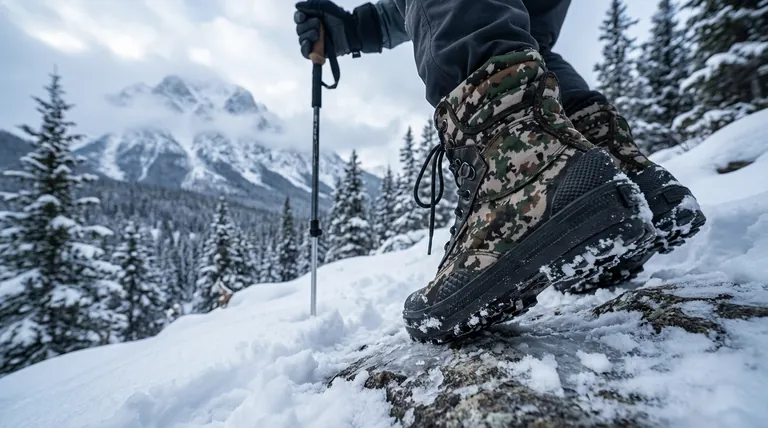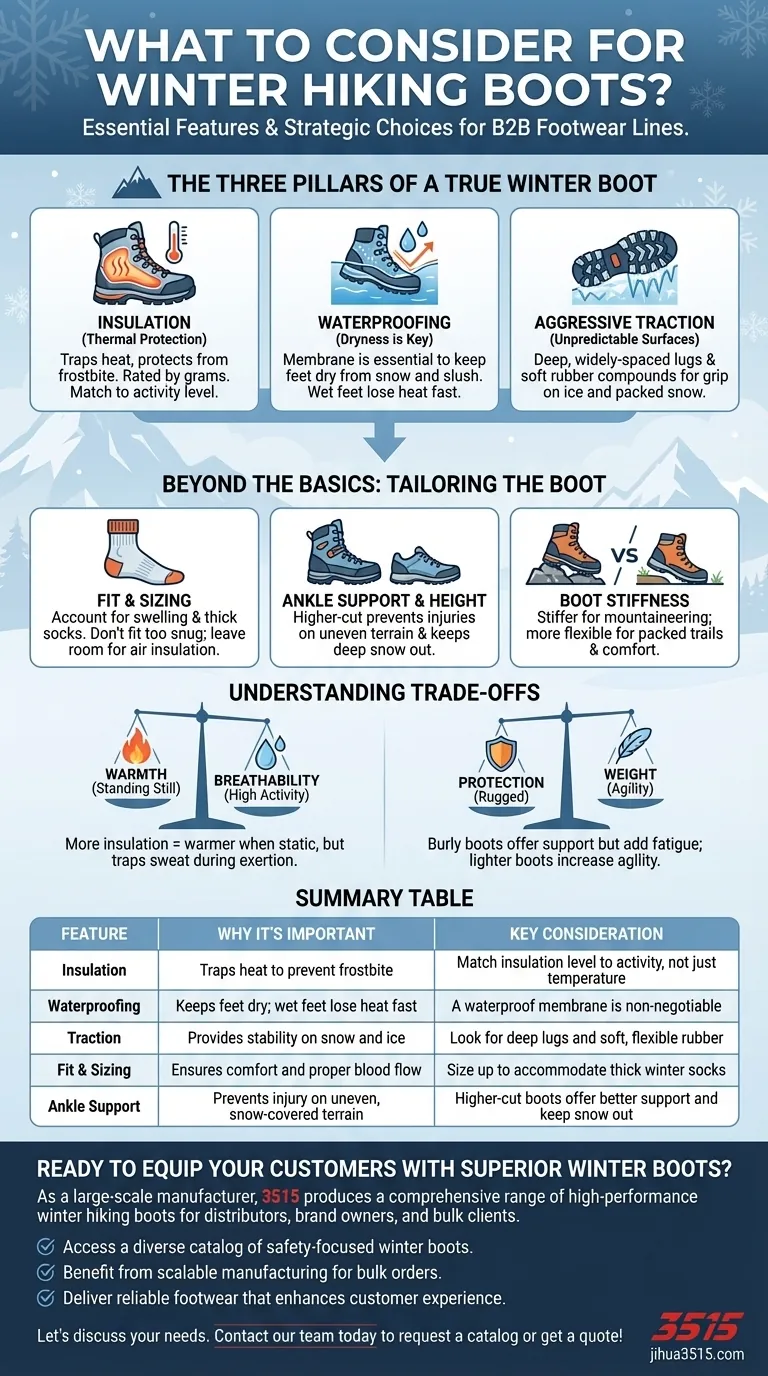The essential considerations for winter hiking boots are insulation for warmth, complete waterproofing to keep your feet dry from snow and slush, and aggressive, deep-lugged outsoles for reliable traction on ice and packed snow. These three features are the non-negotiable foundation that separates a true winter boot from a standard three-season hiker.
The challenge isn't just finding a boot with winter features; it's about matching the level of insulation, stiffness, and support to the specific intensity of your activity and the severity of the conditions you'll face.

The Three Pillars of a True Winter Hiking Boot
A standard hiking boot, even a waterproof one, will fail in true winter conditions. Three specific upgrades are required for safety and comfort when temperatures drop and the ground is frozen.
Insulation for Thermal Protection
Your feet are highly susceptible to cold, and once they get cold, it's difficult to warm them back up. Winter boots have built-in insulation, often rated by grams, to trap heat and protect you from frostbite and discomfort.
Waterproofing for Dryness
Snow is frozen water. Whether you're walking through fresh powder, slush, or crossing a partially frozen stream, moisture is a constant threat. A waterproof membrane is essential to keep your feet dry, as wet feet lose heat exponentially faster than dry ones.
Aggressive Traction for Unpredictable Surfaces
Winter surfaces are inherently unstable, from loose snow to slick ice. Winter-specific outsoles feature deeper, more widely-spaced lugs made from softer rubber compounds that stay flexible in the cold, allowing them to bite into snow and grip slick surfaces effectively.
Beyond the Basics: Tailoring the Boot to Your Hike
Once the core winter features are confirmed, you must consider how the boot's overall design fits your specific hiking style and the terrain you plan to tackle.
The Critical Role of Fit and Sizing
A proper fit is more complex in winter. Your feet naturally swell during a hike, and you must also account for wearing thicker wool or synthetic socks.
A common mistake is buying boots that are too snug. This can restrict blood flow, leading to colder feet, and doesn't leave room for the insulating layer of air your sock is meant to create.
Ankle Support and Boot Height
Winter terrain hides obstacles like rocks and roots under a blanket of snow, increasing the risk of a twisted ankle. Higher-cut boots provide crucial ankle support on this uneven ground.
Taller boots also serve the simple but vital function of keeping snow from falling inside as you walk through deeper drifts.
Matching Boot Stiffness to Your Activity
The boot's rigidity should align with your objective. Stiffer, heavy-duty boots are necessary for mountaineering or kicking steps into hard snow.
For hiking on packed or groomed trails, a more flexible boot will be significantly more comfortable over long distances and require less of a break-in period.
Understanding the Trade-offs
Choosing the perfect winter boot involves balancing competing priorities. Understanding these compromises is key to selecting the right tool for the job.
Warmth vs. Breathability
The more insulation a boot has, the warmer it will be when you're standing still. However, during strenuous activity, that same insulation can trap sweat.
This trapped moisture can eventually make your feet feel just as cold as if they were wet from snow. The key is to match the insulation level to your expected activity level, not just the outside temperature.
Protection vs. Weight
A heavy-duty, burly boot offers maximum protection, support, and durability for rugged, off-trail adventures.
However, that extra weight adds up with every step. For long-distance hikes on less technical terrain, a lighter boot will reduce fatigue and increase your agility, even if it offers slightly less protection.
Making the Right Choice for Your Goal
Select your boot by focusing on your most common type of winter outing.
- If your primary focus is casual day hikes on packed trails: Prioritize a flexible, lightweight, and waterproof boot with moderate insulation.
- If your primary focus is challenging hikes in deep snow and rugged terrain: You need a taller, stiffer boot with substantial insulation and maximum ankle support.
- If your primary focus is fast-paced hiking or winter running: Look for the lightest possible option that still provides essential waterproofing and a reliable winter-specific outsole.
Ultimately, the right winter boot is the one that allows you to forget you're wearing it and focus on the experience.
Summary Table:
| Feature | Why It's Important | Key Consideration |
|---|---|---|
| Insulation | Traps heat to prevent frostbite | Match insulation level to activity, not just temperature |
| Waterproofing | Keeps feet dry; wet feet lose heat fast | A waterproof membrane is non-negotiable |
| Traction | Provides stability on snow and ice | Look for deep lugs and soft, flexible rubber |
| Fit & Sizing | Ensures comfort and proper blood flow | Size up to accommodate thick winter socks |
| Ankle Support | Prevents injury on uneven, snow-covered terrain | Higher-cut boots offer better support and keep snow out |
Ready to Equip Your Customers with Superior Winter Boots?
As a large-scale manufacturer, 3515 produces a comprehensive range of high-performance winter hiking boots for distributors, brand owners, and bulk clients. Our production capabilities ensure every boot meets the essential demands of insulation, waterproofing, and traction, tailored for various winter activities—from casual day hikes to challenging rugged terrain.
Partner with us to:
- Access a diverse catalog of winter boots designed for safety, warmth, and durability.
- Benefit from scalable manufacturing that meets your bulk order requirements without compromising on quality.
- Deliver reliable footwear that enhances your customers' winter hiking experience.
Let's discuss your specific needs and how we can support your business growth. Contact our team today to request a catalog or get a quote!
Visual Guide

Related Products
- Wholesale High-Traction Camo Boots - Custom Manufacturer for Brands
- High Performance Fire-Retardant Waterproof Safety Boots
- Factory-Direct Wholesale Canvas Boots with High-Traction Rubber Soles
- Factory Direct Wholesale Rain Boots Durable Waterproof & Fully Customizable
- Premium High-Cut Waterproof Safety Boots Manufacturing & Wholesale Solutions
People Also Ask
- What benefits do the men's camo boots provide? Superior Protection & Comfort for Demanding Terrain
- What technologies are used in the men's 8-inch camo lace-up boots? A Guide to Rugged Outdoor Performance
- Are military camouflage boots waterproof? How to Choose Boots That Keep Feet Dry
- How is PVC produced? From Salt & Gas to a Versatile Polymer
- How did camouflage use develop during the World Wars? From Artistic Disruption to Scientific Concealment



















